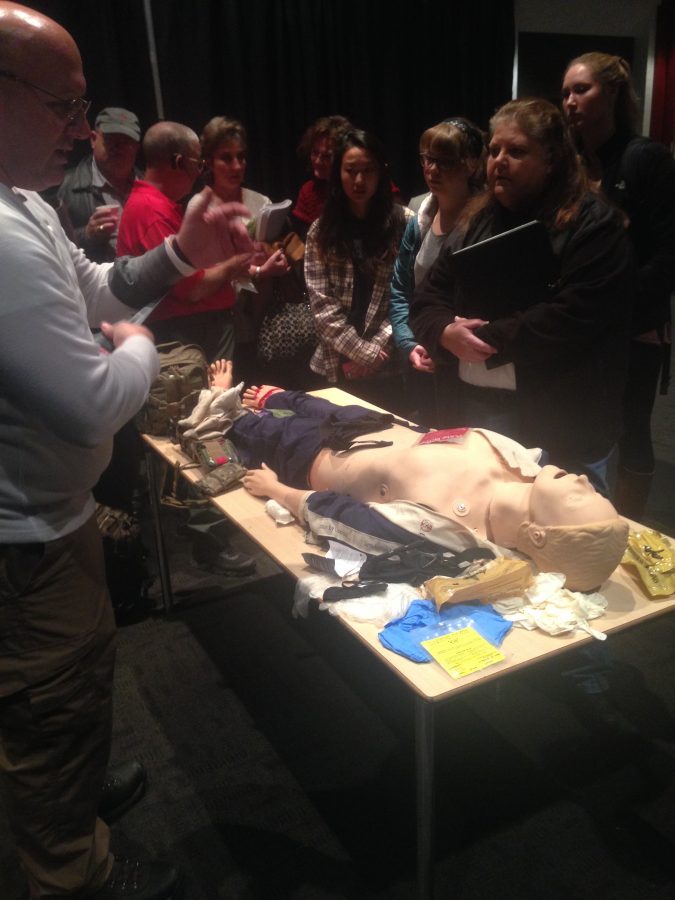The Institute for Rural Health Research hosted the Tuscaloosa Hemorrhagic Control Forum (Stop the Bleeding) on Thursday, Jan. 28, from 9 a.m. to 11 a.m. at the Bryant Conference Center.
The crowd in attendance consisted of police officers, firefighters, EMS personnel, other first responders, church members and members of the general public.
The keynote speaker for the event was Dr. Alexander Eastman, Chief of Trauma at Parkland Memorial Hospital in Dallas, Texas, member of the Hartford Consensus, and a Dallas Police Department Lieutenant on the SWAT team.
The event was focused on, but not limited to, responding to an active shooter situation where there could be potential mass casualties and injuries and how first responders and ordinary citizens can help deal with large blood loss. It also applied to automobile accidents, severe weather injuries and more.
The event began with Glenn Davis, director of EMS for the UA College of Community Health Sciences, introducing Bill McDonald, chaplain for Northstar EMS and DCH Medical Center, to say a word of prayer.
Davis then introduced Dr. John Higginbotham, associate dean of research for the UA College of Community Health Sciences, who welcomed the crowd and thanked them on behalf of the University.
Dr. Eastman then took the stage.
“I think my point today, my take home point to all of you is you go through this training, and it’s a little bit of preaching to the choir, but don’t ever confuse luck for prepared, because those are two very different things,” Eastman said.
He then went on to talk about the increasing frequency of active shooters while displaying a bar graph documenting the numbers over past years.
“The interesting thing about the active shooter in the United States is this is something that is unfortunately increasing in frequency,” he said. “There’s no question that since 2000, now we’re in 2016, these events are occurring more frequently. You don’t have to look at a graph to tell you that. Back in 2000 if somebody went in and shot up a post office, the old ‘going postal’, that was the first story on the news on every news station around the country.”
“It’s not even really at the forefront of our national caucuses anymore and I think that’s really the tragic part,” he said.
After referencing multiple mass shootings, including the Aurora, Colorado theater shooting and the Washington Navy Shipyard shooting, Eastman spoke about who responds and provides trauma care.
“The idea that we have this active shooter response occurring at three distinct silos, a law enforcement phase, a fire rescue and EMS phase, and subsequently a public recovery/definitive phase was just insane,” he said. “We’ve got to get those things to where they can work a little more seamlessly. What’s key is that to survive an active shooter event if you’re wounded, the key thing that has to happen is early hemorrhage control.”
Eastman said that you can train all the first responders you need to, but that who really needs to take the reins is regular citizens equipped with proper training.
“Hemorrhage control, tourniquets, combat gauze, that is the public access to defibrillation in the 21st century,” he said.
“If you put this equipment in the right place. If you train people, if you empower them to use it, they will save themselves, they will save people within your community. They will make you proud.”
At the conclusion of Eastman’s presentation, he took questions from the audience before they broke up into groups and went to the four stations set up where they were shown how to deal with hemorrhaging. One side was for beginners, where professionals displayed the proper tools and how to use them. The other side was for the advanced, where they were shown how to use the tools on medical dummies. Everyone was encouraged to visit each.
Dr. Elwin Crawford, State EMS Medical Director and Emergency Physician at DCH Regional Medical Center, commented on the importance of these types of forums.
“Hemorrhage control is so important because from an EMS side, we certainly know what to do, but what happens before EMS gets there?” Crawford said. “We need to teach the public how to do basic hemorrhage control because for every second or every minute that person is bleeding you have a poor outcome. If you can stop that bleeding by training the general public that’s certainly something that’s beneficial to the patient.”









